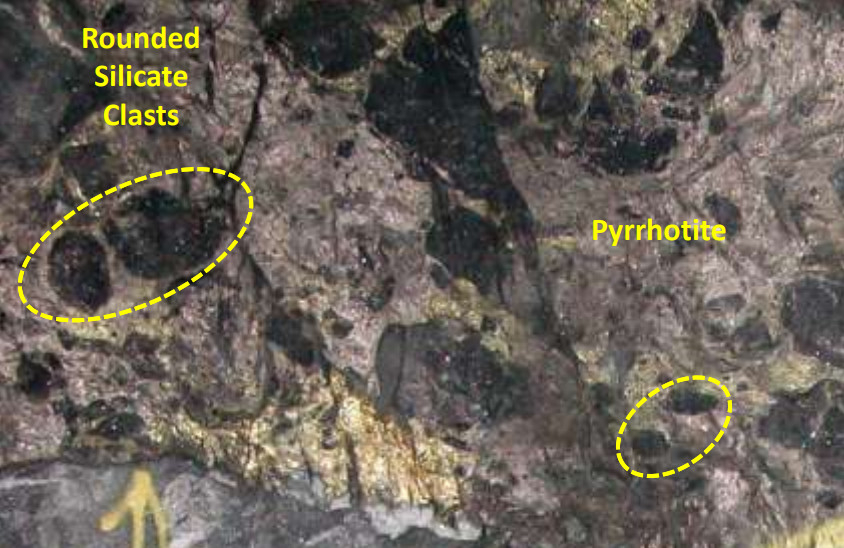
Last week there were a few comments that the Quiz on Structural Geology was not difficult enough – this week we have made it more of a challenge! Your challenge is to beat the GPTAPI that got 7/10 correct. Answers at the end.
1) What is a Durchbewegung texture?
- A mixtures of silicate and competent sulphide clasts (commonly rounded) in a matrix of less competent sulphides
- A texture formed by a fault and a thrust intersecting
- The texture formed at the intersection between a crenulate cleavage and an axial planar fabric
- A tripod of sticks used to support a billy for tea over a fire
2) What is an Allochthon?
- A body of rock that has not been moved from its original position, usually in the footwall of a thrust fault
- Imaginary surface that passes through all the hinge lines of a fold
- A vein filled with mineral fibres, in which the fibres have grown outwards, toward the walls.
- A body of rock that has been moved from its original position, usually in the hanging wall of a thrust fault
3) What is a C-plane?
- Foliation in a shear zone, oriented oblique to the shear zone boundary, representing less deformed regions
- A surface within a shear zone that is characteristically parallel to the zone boundaries and which shows the most intense deformation
- Penetrative foliation defined by mineral grains coarser than ~1 mm.
- A grid of curves, the 3-D equivalent of a protractor.
4) What are Antithetic Riedel shears?
- Subsidiary fractures that form at about 75° to a fault, with sense of displacement opposite to that of the fault.
- Three mutually perpendicular lines in a strain ellipsoid representing the maximum, minimum, and intermediate stretches
- Linear fabric elements that are elongated, continuous domains
- Subsidiary fractures that form at about 25° to a fault, with sense of displacement opposite to that of the fault.
5) What is a Décollement?
- A very extensive flattening on a thrust fault, where there has been a large amount of movement.
- A fold produced when wall rocks accommodate variations in slip between different parts of a fault.
- A region of distortion between the tips of two faults, where slip is transferred from one fault tip to another.
- Underwear commonly worn by an Adult Human Female.
6) What is a tensor?
- A stress regime in which the minimum principal stress is vertical. Reverse faults are common.
- A physical quantity that varies in magnitude with orientation, and can be represented by an ellipse or ellipsoid, or by a square matrix of numbers.
- The line formed by the intersection of a geologic surface with the topographic surface or a cross-section.
- A strike-slip fault that is also a plate boundary.
7) What is a forearc Basin?
- A marine depositional basin on the trench side of a volcanic arc
- A marine depositional basin on the oceanic side of an oceanic arc
- A continental depositional basin formed on the continental side of a continental arc
- A basin formed in an intracratonic rift
8) What are cusps and piercement cusps?
- Platy or flake-shaped mineral grains
- A vein where repeated cracking has occurred in the centre of the vein and mineral fibres are typically in crystallographic continuity with the grains in the wall rock.
- Pinched-in folds at the interface between materials of different competency
- The shape of a deformed circle that originally had unit radius.
9) What is a Sigma porphyroclast?
- Sedimentary structures, such as flute and groove casts, preserved when coarse sediment is deposited rapidly on a muddy substrate
- A high pressure tetragonal polymorph of quartz, in which silicon is in octahedral coordination, surrounded by six oxygen atoms.
- A structure formed by foliation that sweeps around a porphyroclast forming curved, rhombic shape, indicating the sense of shear.
- The envelope in 3D of all stresses (tractions) acting at a point.
10) What is vergence?
- A physical quantity that has magnitude and direction, and can be represented by an arrow.
- Change in position
- The line formed by the intersection of a geologic surface with the topographic surface or a cross-section.
- The direction in which rocks near the surface have moved relative to rocks deeper down.
11) Supplementary Question: What is the texture in the above photograph
- Massive banded sulphides
- Flow banded sulphides
- Crenulate cleavage developed in sulphides
- Durchbewegung Texture
Answers:
- A
- D
- B
- A
- A
- B
- A
- C
- C
- D
- D
Surely the correct answer to question 3 (what is a C plane) is Roy Batty as afterall he told Harrison Ford (the Blade Runner assigned to track him down) had seen C beams glittering on the Tannhauser Gate before all memories were lost like Tears in the Rain . . .
Surely the correct answer to question 3 (what is a C plane) is Roy Batty as afterall he told Harrison Ford (the Blade Runner assigned to track him down) had seen C beams glittering on the Tannhauser Gate before all memories were lost like Tears in the Rain . . . .